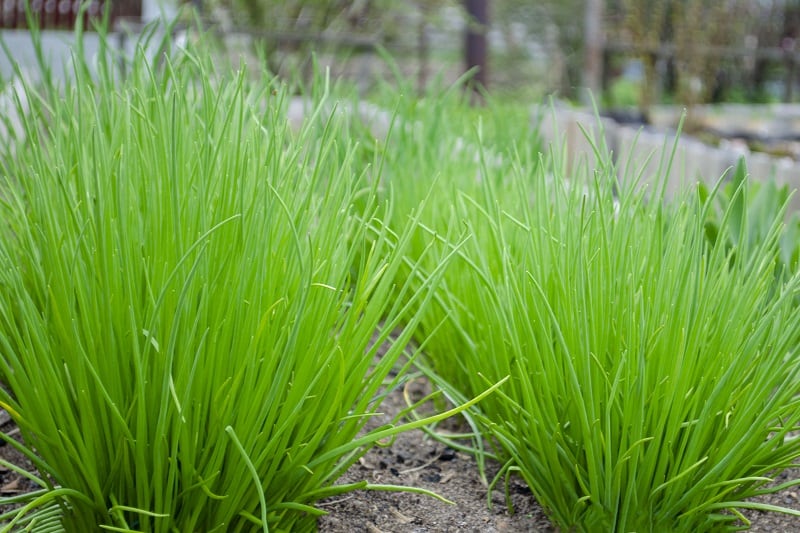
Chives are members of the onion family, with the scientific name Allium schoenoprasum. These companion plants deter pests, have beautiful edible flowers, and are cold-tolerant perennials best planted in early to mid-spring. Chives are close relatives of garlic, leek, scallion, shallot and the Chinese onion. They thrive across Asia, Europe and North America, but like most plants they are also susceptible to disease and discoloration.
Chives Turning Yellow: What Are The Common Reasons?
1. Overwatering
Most beginner plant owners tend to overwater their chives since they worry too much that they are not giving them enough water. Excess water suffocates the chives’ roots and reduces the available oxygen. Roots need to exchange gases, and if this is prevented by factors such as excessive water, the chives will weaken and droop. Leaf burn and yellowing leaves with darker veins are also indicators of overwatering.
Overwatered plants are not able to absorb all the water in the soil and this results in soil that stays wet longer. Low-oxygen and moist environments are breeding grounds for root-rotting bacteria. If this happens, you need to dispose of the plants as they cannot recover from root rot. Overwatering is more of a problem in wintertime, and overwatering your chives even once can kill them.
Underwatering may also cause discoloration, but in this case the plants are more likely to recover if watered regularly. This is less of a problem than overwatering.
A good way to tell whether you are overwatering or underwatering your plants is using the finger or toothpick test. Just insert a finger or a toothpick into the soil and check whether the soil is damp to the touch. If the soil sticks to the toothpick, it means you are overwatering. If the soil does not stick and the toothpick comes out dry, it means you are underwatering and you need to water your chives more.
Watering depends on varying factors such as temperature, the age of your plant, container size, the amount of sunlight received, and the number of leaves.
2. Water salinity level
The kind of water you are using for your chives could also become a factor in why they are turning yellow. Water that is not from the tap may have a salinity content that is too high, which could ruin chives. If the salinity is too high, you might spot whitish salt crusts on the soil’s surface when it is dry. To fix this, check the water salinity with a refractometer or hydrometer. You should also change the soil and transplant your chives.
3. Insufficient light
Chives prefer at least six to eight hours of light daily, just like most plants. They can survive even with only four hours of direct light, regardless of whether it is sunlight or artificial light. If the plants are not exposed to at least four hours of light they may develop droopy and yellowing leaves. You can compensate for a lack of light by using a grow light, so that the plants still have access to light for a few hours each day.
4. High temperatures
Chives prefer, and thrive in, cold temperatures. They could become stressed if exposed to hot temperatures and environments close to 80 degrees Fahrenheit. This will likely trigger a dormant state in your plants and they may stop growing and become droopy. There is also a potential risk of sunburn, so you should water the chives more often to nurse them back to health.
5. Pest infestation
While usual plant pests do not like chives because of their taste, they are still prone to attacks by onion maggots and thrips. This could cause drooping and yellowing leaves. These pests are often spotted at the base of the plant where they lay white eggs. These insects look like common flies and create tunnels in the chive bulbs, causing root rot and possible diseases.
Thrips are similar to aphids, in that they suck the plant’s nutrients and fluids from the leaves. The larvae are white, semi-transparent bugs that spend most of their time feeding on leaves. The adults are brownish/dark, have four legs and wings with hair. You will know there are thrips in your chives when there are silver patches and small black spheres on the leaves, which are their excrement.
To fix the pest issue, you need to use sticky sheets that attract and trap thrips. You can also use insecticides or organic pesticides like neem oil. Soapy water or isopropyl rubbing alcohol may also be used to spray or wipe on the plants.
6. Poor potting mix
This is usually old and overused soil that has been already used for a long period. It limits the exchange of gases and the plants may start to suffocate and become droopy. Check if the surface soil is hard to break and if the water sits on top of the soil before passing through the pot. These are the usual signs of compacted soil.
To fix the issue, you need to replace the potting soil and move the soil each time you water the plants to allow more air to get in through the soil.
Conclusion
Chives turning yellow could be attributed to overwatering or high temperatures, which are intolerable for these cold-resistant perennials. It could also be due to poor potting mix, pest infestation or insufficient light.
Image: istockphoto.com / Oksana Akhtanina